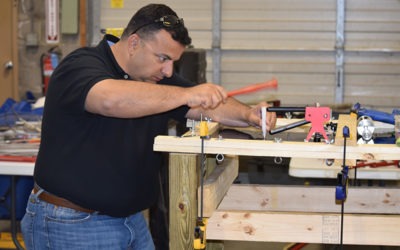Sneaky PDR Training Sales Tactics are alive and well today! I had to deal with these tactics when I learned paintless dent repair back in the 1990s. So, as I expose these tactics, just keep in mind the old adage “buyer beware” applies when researching PDR training.
1. “1 to 1” PDR Training Bait & Switch
This is a common tactic in their information. They offer a premium service of having your own trainer leading and guiding you over your shoulder every minute of the instruction experience. But what you get is the “PDR training mill” experience. You are treated to a classroom full of people and an instructor up front that you rarely speak with. When it’s time to do practical exercises, the instructor sees you just for a minute or so. It’s not what you are promised by the slick marketing and packaging of PDR training companies.
What to Look For:
How many students are in class? What is the student-to-instructor ratio? If the ratio is more than 4 to 1, then there are too many students per instructor. In the PDR Industry, we term this a “PDR Mill Trainer.” If you find yourself in a “PDR Mill” situation, ask for your money back right away and leave. You will be getting inferior PDR training and may learn bad PDR skill habits that may never be corrected.
2. “We Train Everywhere” Bait & Switch
This sales tactic is hard to tell at first. It’s because they will schedule you into a class at a location near you. Then, they call back with the excuse that class is canceled and schedule you to go to the training center in California. Another scenario is they say the class is full, and you need to come to the California training center. Just understand that these are California-based training companies and want you to come to their training centers there. They do not have locations in other places and are renting space to do the training. They either have to charge you more for the remote training or get more students, which is why they are “PDR Mill Trainers.”
What to Look For:
Pricing difference between California and the remote site. $8000 quoted in California, but $10,000 quoted in Texas or Florida. This is because the training company is “brokering” the training. They are not the ones doing the training and rent a trainer, not even a PDR trainer, to perform the training. Also, if there are not enough students at the remote location, expect training to be canceled, and you will be told to come to California.
3. “All-Inclusive” Package Training
The full package deal: training, tools, travel, and accommodations….for just one price! They don’t tell you that they are making a profit on all those package parts, and it is overpriced up to $2000 if you price it all yourself. They make it sound great, but you should feel like they are selling you. It’s the same feeling people have when trapped in a timeshare presentation. It all sounds good, but why do I feel like I am being taken advantage of? Be a shopper and price it all yourself.
What to Look For:
“We will do it all for you. Fly you out. Put you up. Give you tools. Train you.” You will be quoted $8000 to $20,000. Sounds kind of like “Time Share” marketing, which has large profit margins built in. Shop the individual parts yourself for the best value. A trainer should advise you, not sell you!
4. Misleading Company Names on Multiple Websites
Interesting to see all the websites about PDR training, but they all sound the same…but with different names? Yes, they are all the same California-based companies. Why are they hiding their name? This is because they have a questionable reputation, and they do not want you to learn their true identity until they call you. They are using these sneaky sales tactics to confuse you. If they are deceiving you with this tactic, how else are they lying to you?
What to Look For:
If all those form fills to different branded PDR training sites and get responded to by one source, then you know it’s a sneaky sales tactic. You have reached marketing companies that use PDR training as a marketing device and not a real industry PDR trainer.
5. State Certified Instruction
A big sales tactic that is deceptive. There is a big difference between being “State” certified and “Industry” certified. State certification means they have a training program that fits a certain structure. They could be “state certified” to train anything from basket weaving to elephant feeding. That is much different than being PDR Industry certified. Currently, industry certification is awarded by Paintless Dent Repair University, Vale, PDR Nation, Dent Wizard, and ARC. They certify technicians but not trainers. There is no PDR trainer Certification to date.
What to Look For:
National or PDR industry certification of your instructor. Ask the question,” What is your certification number?” The response from me will be,” My Vale certification number is #10085, and it was awarded February 26, 2004″. If your trainer is not certified…then don’t train with them! The non-legitimate trainers will try to downplay industry certification….because they are not!
6. Suspect Reviews of PDR training
Always ask for references. I am always amused by the PDR training companies that shoot videos of students in class or just completing their training, saying they had a great training experience. Well, sure, I would say that also if I had been pumped up and told that you are going to be a great PDR technician.
What to Look For:
Videos of students in class giving reviews. Those legitimate reviews are ones given at least 6 months after training. Check out the PDR Training company or trainer by asking for references from alumni who have graduated for more than 6 months. If they won’t furnish references, then don’t train with them. It’s one way to judge whether you will see success after completion of class.
7. Money Back Guarantee
This is not a valid guarantee. This is a sales tactic. The legit PDR industry trainers will give you a training guarantee that allows you to come back through training for free if you need to come back for refresher classes. The good trainers in the PDR industry are concerned about students learning PDR properly and will keep working with them until they are able to perform PDR. I have never had a student who could not learn PDR, so the money-back guarantee does not make sense for the good PDR trainers. But coming back, if needed, makes perfect sense.
What to Look For:
If it’s too good to be true. The leading PDR training marketer has it both ways on its website: “Guaranteed Lifetime Training” and “Money Back Guarantee”. If it is confusing on the front end of training, then the guarantee is not valid if you have to redeem it. Look for others who have been told the excuse,” We can’t give you money back because it’s been too long since you trained.” It can take a while before you understand that your training was not proper.
8. No Name Low Quality Tools
The California “Mill” PDR training companies are pushing low-quality, no-name PDR tools. They are including the tools in their inclusive package deals and are making tons of profits. This is an injustice to send a new technician out into the field with inferior tools. The PDR industry uses high-quality, finely tuned instruments to make repairs. There are only a few quality PDR companies making these tools. For a list of high-quality manufacturers, check out my PDR Tools page.
What to Look For:
Ask these questions. Who is the tool manufacturer? What is their website? Can I buy directly from them? No PDR trainers or training companies manufacture their own PDR tools. If the tools are not made by the legitimate PDR Manufacturers like A-1 PDR Tools, Dentcraft PDR Tools, PDR Finesse PDR Tools, or Ultra PDR Tools, then don’t train with them or buy their tools. Buy quality tools to make quality repairs!
9. High-Pressure Sales Commitment
Paintless Dent Repair is a profitable skill to learn, and it sells itself. Beyond explaining why you need hands-on training and selecting a trainer, there is no selling involved. So, why are there high-pressure sales tactics from the “PDR Mill” trainers? It’s because they have been doing it for so long, and their sales tactics get results. It doesn’t mean you have to be a victim. I have wanted to expose these tactics for a long time, since they make a very easy-to-understand process of learning PDR difficult. It’s the design of these PDR marketing companies that gets you confused and worn out. At that point, you are expected to just give in to them and waste your time, effort, and money. If you have ever been through a timeshare presentation, it is the same sneaky sales process.
What to Look For:
Slick, persistent, high-pressure training companies that are making profits by pumping students through their organizations. It’s a timeshared sales process, and it does not respect people. It’s all about volume and profit. You don’t have to participate in this sales process. Ask lots of questions and don’t choose a trainer under pressure. Go with your gut feeling, if you are being sold…then you are. Just say no! Do your research and choose the best PDR trainer for you.
10. “That Trainer Used to Train for My Organization” Lie
A deceptive tactic used by some unsavory PDR training companies is the claim, “That guy used to train for us!” I have been approached by some training companies from California to conduct their training here in the Midwest/East Coast. They also wanted me to sell their tools to my students. However, after evaluating their offers, it was clear they wanted my reputation as an industry-leading trainer to lend credibility to their training and tools. If you hear this line, they are grasping at straws because their training is suspect. Say goodbye and look for another trainer.
What to Look For:
“That guy used to train for us.” This doesn’t make their PDR training legitimate. Do your research and examine the facts about the PDR training they are providing.
11. Will Not Furnish References
Ask for a few references. If they are training properly, references will reveal how well a student was equipped to work in the real world of PDR. If there are no references, look for a trainer who will provide them. Then ask the references plenty of questions about their training experience. Good research gives you confidence that you are making the right decision on a trainer.
What to Look For:
Refusal to give references. This is a big red flag, and you shouldn’t train with them.
12. Hands-On Bait & Switch
You won’t discover the hands-on bait and switch tactic until you get to the training. But when it happens, you will know it. You are promised learning dent repair, but end up in class most of the time. PDR training is a skill to be learned and should be the main focus of the instruction. The hands-on portion should be 80% of the training. The student should be working on dent repair from the first day and throughout all the training days.
What to Look For:
“How much am I learning, and what types of repairs will I make every day? Please provide me with a class curriculum.” If the training is not clearly detailed by day, you may not be able to judge how much classroom versus practical application the training is. Ask questions about hands-on repairs and what you will learn. If you are making difficult repairs like softball-sized dents and creases during training, then there is likely enough hands-on training.

